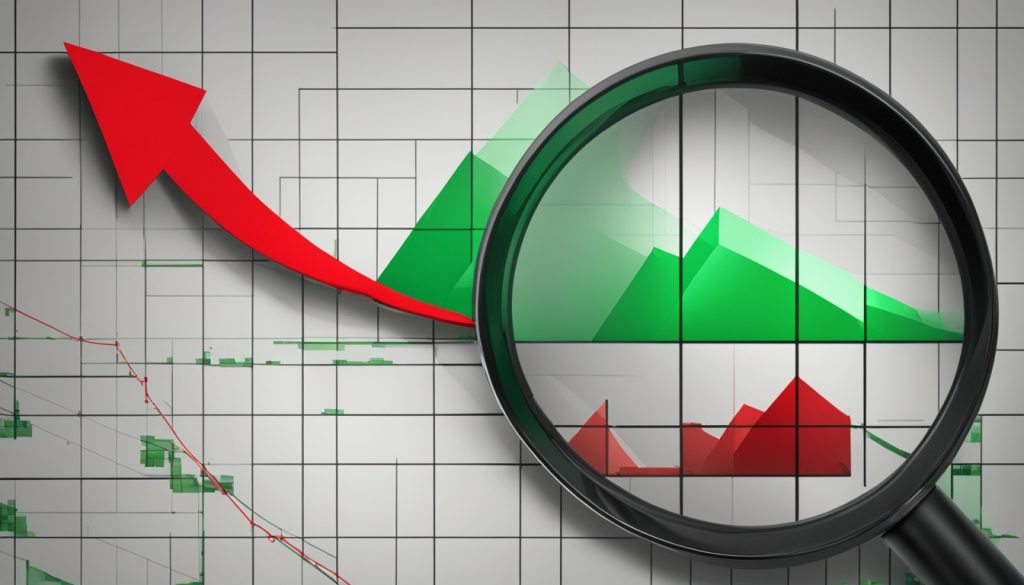Loss Given Default (LGD) is key in banking risk management today. It shows the possible loss a lender might face if a borrower can’t pay back their loan1. LGD is a percentage of the total loan value at default. It’s found by taking the recovery rate away from 100%2. Knowing LGD well helps banks manage risks, decide on capital, and make smart choices1.
LGD models help with big decisions like setting loan prices and managing credit portfolios1. There are two types: Long-Run for loans that are still good and In-Default for loans that aren’t1. It’s vital for banks to understand and estimate LGD well. This helps them make smart decisions, manage risks, and set the right interest rates2.
Key Takeaways
- Loss Given Default (LGD) is a key credit risk measure. It shows the potential loss a lender might face if a borrower defaults.
- Getting LGD right is key for good risk management, deciding on capital, and making choices in finance.
- LGD models affect big decisions like setting loan prices and managing credit portfolios.
- LGD can be split into Long-Run for good loans and In-Default for bad loans.
- Understanding and estimating LGD well is crucial for banks. It helps them make informed decisions, manage risks, and set the right interest rates.
What is Loss Given Default (LGD)?
Loss Given Default (LGD) is a key idea in credit risk. It shows the possible loss a lender might face if a borrower defaults3. LGD is a percentage of the total loan value at default3. To find LGD, you subtract the recovery rate from 100%4.
For instance, with a 60% recovery rate, the LGD is 40% (100% – 60%)4. This means the lender could lose 40% of the loan if the borrower defaults3. Knowing LGD helps banks make smart decisions about loans, pricing, and managing risk3.
LGD is a better scenario than EAD because it includes any recovery from default4. Both LGD and EAD help banks understand potential losses3.
| Metric | Description |
|---|---|
| Loss Given Default (LGD) | The estimated amount of money a financial institution loses when a borrower defaults on a loan, represented as a percentage of total exposure at the time of default or a single dollar value3. |
| Exposure at Default (EAD) | The total loan value at the time of default, which continuously changes as the borrower pays down the loan3. |
| Probability of Default (PD) | The likelihood that a borrower will default on their loan obligation. |
| Expected Loss | The quantification of potential losses, calculated as LGD multiplied by both the probability of default and the exposure at default3. |
LGD is key in the Basel Model, global banking rules3. Banks use past data and risk groups to guess recovery rates and LGD for different assets4.
Importance of LGD in Credit Risk Modeling
Loss Given Default (LGD) is key in credit risk modeling for banks5. It shows the loss from a borrower defaulting compared to the risk6. Banks use the Standardized Approach (SA) or Internal Ratings-Based Approach (IRBA) to figure out their capital needs5. Getting LGD right helps banks manage risk better and stay competitive5.
Defaulted loans can either fully recover or not at all, making LGD hard to predict5. The Small Business Administration (SBA) dataset is often used for studying default risks5. Unsupervised learning can help avoid overfitting in LGD models5.
A new Hybrid Algorithms Multi-Stage (HMS) model aims to improve LGD accuracy5. This model breaks down credit risk into stages, focusing on different risk factors and data5. Metrics like Mean Absolute Error (MAE), Explained Variance (EV), and Mean Squared Error (MSE) measure how well LGD models do5. The HMS model helps in better credit risk management and meets regulatory needs5. It uses both supervised and unsupervised learning to boost LGD forecasting and make it more reliable5.
LGD is often seen as a ratio of losses to an exposure at default6. There are different ways to estimate LGDs, like from internal data, market estimates, and implied market values6. Estimating LGD at the product level makes it easier to handle and estimate6.
Banks calculate expected credit losses by discounting cash flows to the default date6. LGD modeling looks at both non-defaulted and defaulted accounts, focusing on future outcomes6. Techniques like regression and machine learning help in modeling LGD to predict losses for similar accounts6.
Survival analysis methods like Cox Proportional Hazard (CPH) and Accelerated Failure Time (AFT) are used for LGD modeling6. When data quality is poor, simpler methods and qualitative assessments are needed for LGD modeling6. The quality of LGD data affects how complex and reliable the models can be6.
Checking model validation is key for ensuring data and methods are correct for accurate ECL estimation6. LGD modeling uses various techniques like micro-structure approach, regression, machine learning, and survival analysis6. A Monte Carlo simulation helps in calculating portfolio credit loss, showing a chance of small losses6. Different models like CreditMetrics and copulas are used for credit risk assessment6. The IRB framework uses unexpected loss to set capital requirements and Risk-Weighted Assets (RWA)6.

loss given default Estimation Methodologies
Estimating Loss Given Default (LGD) is key to managing credit risk. Financial institutions use different methods to figure out this important number. Each method has its own benefits and uses7.
Statistical Modeling
One way to estimate LGD is through statistical modeling. This method looks at past data to guess potential losses if a default happens. It considers things like the value of collateral, how much can be recovered, and industry specifics to calculate LGD7. For instance, a bank might use a model that looks at these factors to guess LGD for its loans7.
Machine Learning Techniques
Financial institutions are also looking into machine learning for LGD estimation. Techniques like decision trees and neural networks are promising. They can handle complex relationships between LGD and its factors7. These methods give more precise and detailed LGD estimates, helping with better risk management and decision-making7.
| LGD Estimation Methodology | Key Features | Advantages | Challenges |
|---|---|---|---|
| Statistical Modeling |
|
|
|
| Machine Learning Techniques |
|
|
|
The choice of LGD estimation method depends on the institution’s needs, data, and risk management goals. Using advanced techniques helps organizations improve their credit risk management. This leads to better decisions7.
Factors Influencing LGD
Knowing what affects the Loss Given Default (LGD) for loans is key for managing risks. These factors can greatly change the economic loss a lender might face if a borrower defaults.
Collateral and Debt Seniority
Having collateral can really change LGD, as lenders can sell it to get back some of the debt8. Also, the order of debts in the borrower’s structure matters. Senior debts get paid back first, making them less risky.
Economic Conditions and Recovery Processes
The economy’s state can change LGD, making recovery harder during tough times and raising LGD8. How well and quickly a recovery process works also affects LGD.
| Factor | Impact on LGD |
|---|---|
| Collateral Value | Higher collateral value leads to lower LGD |
| Debt Seniority | Senior debt has lower LGD than junior debt |
| Economic Conditions | Weaker economic conditions result in higher LGD |
| Recovery Processes | Efficient recovery processes lead to lower LGD |
Understanding these factors helps banks better manage risks. They can improve how they model credit risks, allocate capital, and manage risks overall89.

Regulatory Implications and Basel III Framework
The Basel III framework focuses on accurately estimating Loss Given Default (LGD) for banks10. It’s key to figuring out how much capital banks need10. The framework gives clear rules for making and checking LGD models10.
Basel III’s Comprehensive Approach
Basel III doesn’t just look at LGD. It aims to make bank capital better by focusing on Common Equity Tier 1 (CET1) capital10. It also updates how it measures risk, introduces new rules for managing liquidity, and sets a leverage ratio to control bank leverage10.
Basel III updates how it looks at credit risk, giving more detailed risk weights for banks and companies10. It has different risk weights for not-rated and rated exposures, and for small and medium-sized enterprises (SMEs)10. It also has new rules for real estate, retail, commercial real estate, subordinated debt, and equity exposures10.
“The Basel III framework provides a comprehensive set of reforms to strengthen the regulation, supervision, and risk management of the banking sector.”11
Following Basel III guidelines helps banks manage credit risk better, making the banking sector more stable and resilient1011.

Conclusion
Understanding Loss Given Default (LGD) is key for banks and other financial groups. LGD shows the possible loss a lender might face if a borrower can’t pay back. It’s important for managing risks, like setting loan prices and diversifying credit portfolios12.
Knowing how to estimate LGD helps banks make smarter choices. This way, they can handle risks better and make their credit portfolios stronger1213.
This article has covered how to analyze and understand LGD. It gives banks a strong base to improve their risk management1213. By using LGD in their risk models, banks can deal with financial challenges better. This makes their operations more stable and secure12.
The need to grasp and manage LGD will keep growing as the financial world changes. Banks that stay ahead in credit risk management will do well. They’ll be ready for defaults and economic ups and downs1213.
FAQ
What is Loss Given Default (LGD)?
Loss Given Default (LGD) is a key idea in credit risk. It shows the possible loss a lender might face if a borrower can’t pay back their loan. LGD is the loss as a percentage of the loan’s value at default. It’s found by taking 100% and subtracting the recovery rate.
Why is LGD important in credit risk modeling?
LGD is vital for figuring out expected credit losses. These losses help set capital needs and loan prices. Getting LGD right helps with managing risks, planning for capital, and making smart decisions in finance.
How is LGD estimated?
Statistic models are often used to estimate LGD, looking at past data and regression analysis. New methods like decision trees and neural networks are being tested too. They aim to better understand how LGD changes with different factors.
What factors influence LGD?
Things like collateral quality, debt seniority, and economic conditions affect LGD. These factors play a big role in how much loss a lender might see if a borrower defaults.
How does the Basel III framework address LGD?
Basel III focuses a lot on accurate LGD estimation and its role in setting capital needs. It gives clear rules for making and checking LGD models. This ensures banks have a solid way to measure this important credit risk.
Source Links
- Understanding LGD Risk
- Understanding Loss Given Default in Credit Risk Portfolio Modeling 2 – FasterCapital
- Loss Given Default (LGD): Two Ways to Calculate, Plus an Example
- LGD (Loss Given Default)
- Assessing the Loss Given Default of Bank Loans Using the Hybrid Algorithms Multi-Stage Model
- Loss Given Default – an overview
- VisibleBreadcrumbs
- Microsoft Word – Frye Loss Given Default and Economic Capital.doc
- High-level summary of Basel III reforms
- Basel III: A global regulatory framework for more resilient banks and banking systems – post BCBS meeting – revised version June 2011
- Loss Given Default (LGD)
- What Drives Loss Given Default? Evidence from Commercial Real Estate Loans at Failed Banks

